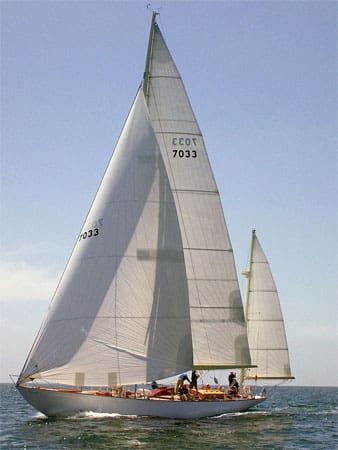Every legend has a beginning and this one begins simply enough. Two brothers, who turn out to be prodigies, manifesting their genius designing, constructing, and racing sailboats. Combine that with a father who had the wherewithal to support his sons’ dreams. Add a bit of good luck and the legend of Olin and Rod Stephens takes shape.
It was Dorade, a 52-foot yawl that Olin designed when he was 20 years old and that Rod, a year younger, supervised building and then rigged that proved to be their breakthrough. Dorade was built on City Island, N.Y., in 1930. On her first race to Bermuda, Dorade finished third overall and second in class.
Dorade was yawl-rigged, 52 feet LOA, 37 feet, 3 inches on deck, with a 7-foot, 8-inch draft carrying 1,150 square feet of sail, and was initially launched with no auxiliary power. Tiller-steered, Dorade displaced 37,800 pounds, quite heavy for her size, but her steam bent white oak frames were placed 9 inches apart, instead of the usual 11.5 inches, to give her more strength.
Eleven boats departed Newport, R.I., on July 4, 1931, to race to England and by the time the race was over a little more than 16 days later, Dorade had won the race by two days boat for boat and on a corrected time by almost four days. Dorade was the third smallest in the fleet. The average age of the crew was 22 including 46-year-old Roderick Stephens Sr., the proud patriarch.
Rod was an ace celestial navigator, having learned from none other than George Mixter himself. With the confidence of youth they chose a course from Newport to Plymouth that was fraught with potential hazards but was also shorter. While the rest of the racers went south of Sable Island, Dorade took the more northerly route sailing between Sable Island and the coast of Nova Scotia.
Likewise, the brothers went inside Virgin Rocks off the south coast of Newfoundland where they saved more than 100 miles. They had been dead-reckoning for a few days and unsure of their position. When the sun broke the clouds, Rod grabbed the sextant and got a shot off. The sextant was always handy because they had built a special compartment close to the cockpit for it.
They won the Transatlantic Race and later that summer went on to win a very tough Fastnet Race. When Dorade was shipped back to New York, the crew arrived home and were received with a ticker-tape parade up Broadway, the only time American yachtsmen have been so honored. In 1932, Dorade won Class 2 in the Bermuda Race, then sailed to Norway and did the Fastnet, winning a second time. Later in the decade Dorade was sold. It won its first Transpac in 1936. It continued its racing career, was bought and sold, and in 2013, under new ownership, after much restoration, Dorade won the Transpac again, quite a legacy for a yacht more than 80 years old, designed by boys barely out of their teens.
Let’s join Dorade on its way to Europe, taking a sun line, doing a sun shot for a line of position. The date is July 13. We’ll be using the 2013 Nautical Almanac. Height of eye is 8 feet. There is no sextant error and no time error. At 09:27:10 GMT Rod takes a lower limb observation of the sun. The DR is 48° 45’ N by 41° 15’ W. The Hs is 21° 50.1’.
A. What is the Ho?
B. What is the intercept?
C. What is the EP after you have plotted?
(See answers below)
ANSWERS:
A. Ho is 22° 01.0’
B. Intercept is 1 nm away
C. EP is 48° 44’ N by 41° 23’ W

